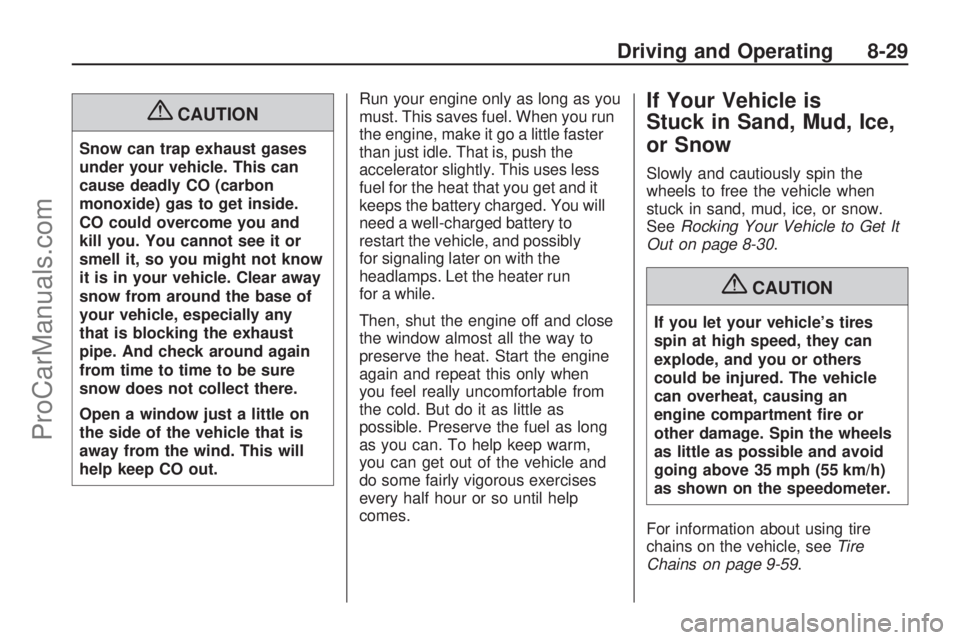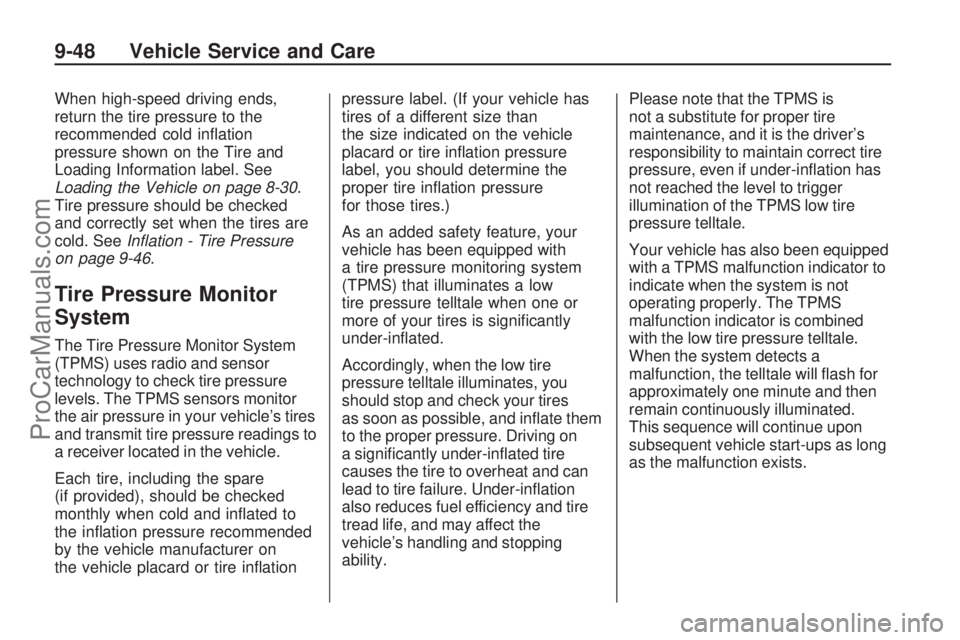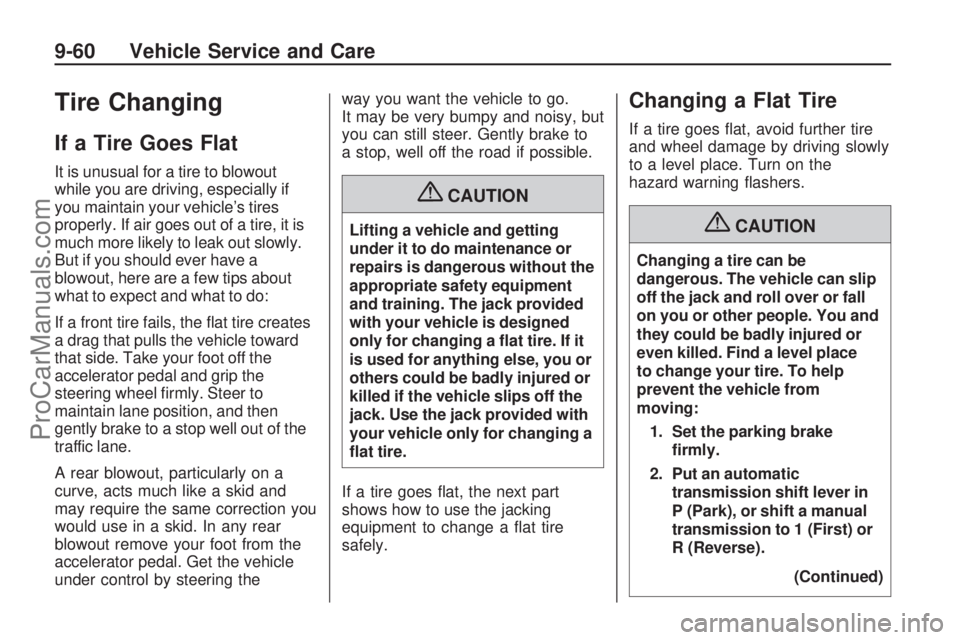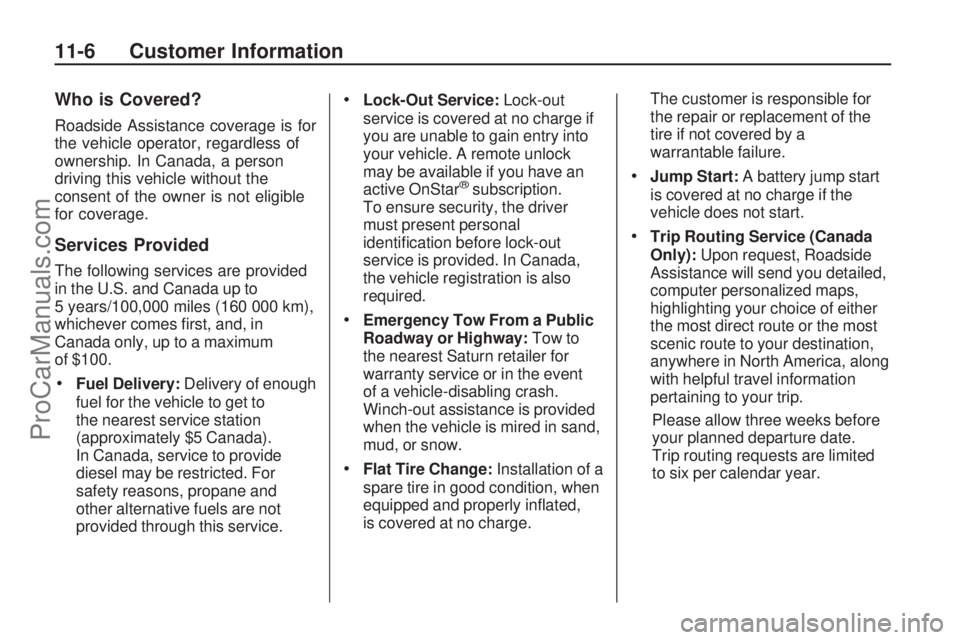ESP SATURN ASTRA 2008 User Guide
[x] Cancel search | Manufacturer: SATURN, Model Year: 2008, Model line: ASTRA, Model: SATURN ASTRA 2008Pages: 304, PDF Size: 1.92 MB
Page 175 of 304

Turn the steering wheel 3 to
5 inches (about one-eighth turn)
until the right front tire contacts the
pavement edge. Then turn the
steering wheel to go straight down
the roadway.
Passing
Passing another vehicle on a
two-lane road can be dangerous.
To reduce the risk of danger
while passing:
Look down the road, to the sides,
and to crossroads for situations
that might affect a successful
pass. If in doubt, wait.
Watch for traffic signs, pavement
markings, and lines that could
indicate a turn or an intersection.
Never cross a solid or
double-solid line on your
side of the lane.
Do not get too close to the vehicle
you want to pass. Doing so can
reduce your visibility.
Wait your turn to pass a slow
vehicle.
When you are being passed, ease
to the right.
Loss of Control
Let us review what driving experts
say about what happens when
the three control systems — brakes,
steering, and acceleration — do
not have enough friction where the
tires meet the road to do what
the driver has asked.
In any emergency, do not give up.
Keep trying to steer and constantly
seek an escape route or area of
less danger.
Skidding
In a skid, a driver can lose control of
the vehicle. Defensive drivers avoid
most skids by taking reasonable care
suited to existing conditions, and by
not overdriving those conditions.
But skids are always possible.
The three types of skids correspond
to your vehicle’s three control
systems. In the braking skid, the
wheels are not rolling. In the steering
or cornering skid, too much speed or
steering in a curve causes tires to
slip and lose cornering force. And
in the acceleration skid, too much
throttle causes the driving wheels
to spin.
A cornering skid is best handled
by easing your foot off of the
accelerator pedal.
Driving and Operating 8-23
ProCarManuals.com
Page 176 of 304

If your vehicle starts to slide, ease
your foot off the accelerator pedal
and quickly steer the way you want
the vehicle to go. If you start steering
quickly enough, your vehicle may
straighten out. Always be ready for a
second skid if it occurs.
Of course, traction is reduced when
water, snow, ice, gravel, or other
material is on the road. For safety,
you want to slow down and
adjust your driving to these
conditions. It is important to slow
down on slippery surfaces because
stopping distance is longer and
vehicle control more limited.
While driving on a surface with
reduced traction, try your best to
avoid sudden steering, acceleration,
or braking, including reducing
vehicle speed by shifting to a lower
gear. Any sudden changes could
cause the tires to slide. You
might not realize the surface isslippery until your vehicle is
skidding. Learn to recognize warning
clues — such as enough water,
ice, or packed snow on the road to
make a mirrored surface — and
slow down when you have any
doubt.
Remember: Any Antilock Brake
System (ABS) helps avoid only the
braking skid.
Driving at Night
Night driving is more dangerous
than day driving because some
drivers are likely to be impaired — by
alcohol or drugs, with night vision
problems, or by fatigue.
Night driving tips include:
Drive defensively.
Do not drink and drive.
Reduce headlamp glare by
adjusting the inside rearview
mirror.
Slow down and keep more space
between you and other vehicles
because headlamps can only
light up so much road ahead.
Watch for animals.
When tired, pull off the road.
Do not wear sunglasses.
Avoid staring directly into
approaching headlamps.
Keep the windshield and all glass
on your vehicle clean — inside
and out.
Keep your eyes moving,
especially during turns or curves.
No one can see as well at night as
in the daytime. But, as we get
older, these differences increase.
A 50-year-old driver might need
at least twice as much light to see
the same thing at night as a
20-year-old.
8-24 Driving and Operating
ProCarManuals.com
Page 181 of 304

{CAUTION
Snow can trap exhaust gases
under your vehicle. This can
cause deadly CO (carbon
monoxide) gas to get inside.
CO could overcome you and
kill you. You cannot see it or
smell it, so you might not know
it is in your vehicle. Clear away
snow from around the base of
your vehicle, especially any
that is blocking the exhaust
pipe. And check around again
from time to time to be sure
snow does not collect there.
Open a window just a little on
the side of the vehicle that is
away from the wind. This will
help keep CO out.Run your engine only as long as you
must. This saves fuel. When you run
the engine, make it go a little faster
than just idle. That is, push the
accelerator slightly. This uses less
fuel for the heat that you get and it
keeps the battery charged. You will
need a well-charged battery to
restart the vehicle, and possibly
for signaling later on with the
headlamps. Let the heater run
for a while.
Then, shut the engine off and close
the window almost all the way to
preserve the heat. Start the engine
again and repeat this only when
you feel really uncomfortable from
the cold. But do it as little as
possible. Preserve the fuel as long
as you can. To help keep warm,
you can get out of the vehicle and
do some fairly vigorous exercises
every half hour or so until help
comes.
If Your Vehicle is
Stuck in Sand, Mud, Ice,
or Snow
Slowly and cautiously spin the
wheels to free the vehicle when
stuck in sand, mud, ice, or snow.
SeeRocking Your Vehicle to Get It
Out on page 8-30.
{CAUTION
If you let your vehicle’s tires
spin at high speed, they can
explode, and you or others
could be injured. The vehicle
can overheat, causing an
engine compartment �re or
other damage. Spin the wheels
as little as possible and avoid
going above 35 mph (55 km/h)
as shown on the speedometer.
For information about using tire
chains on the vehicle, seeTire
Chains on page 9-59.
Driving and Operating 8-29
ProCarManuals.com
Page 229 of 304

CAUTION (Continued)
Worn, old tires can cause
accidents. If your tread
is badly worn, or if your
tires have been damaged,
replace them.
SeeHigh-Speed Operation
on page 9-47for in�ation
pressure adjustment for
high speed driving.
Low-Pro�le Tires
If the vehicle has 225/40ZR18
or 215/45R18 size tires, they
are classi�ed as low-pro�le
performance tires. These tires
are designed for very responsive
driving on wet or dry pavement.
You may also notice more
road noise with low-pro�le
performance tires and that they
tend to wear faster.
Notice:If the vehicle has
low-pro�le tires, they are
more susceptible to damage
from road hazards or curb
impact than standard pro�le
tires. Tire and/or wheel
assembly damage can occur
when coming into contact with
road hazards like, potholes,
or sharp edged objects,
or when sliding into a curb.
The vehicle warranty does not
cover this type of damage.
Keep tires set to the correct
in�ation pressure and,
when possible avoid contact
with curbs, potholes, and
other road hazards.Winter Tires
If the vehicle has 225/40ZR18 or
215/45R18 size tires, they are
classi�ed as low-pro�le performance
tires. These tires are designed for
very responsive driving on wet or dry
pavement. If you expect to drive
on snow or ice covered roads often,
you may want to get winter tires
for your vehicle. All season tires
provide good overall performance on
most surfaces but they may not
offer the traction you would like or
the same level of performance
as winter tires on snow or ice
covered roads.
Winter tires, in general, are
designed for increased traction on
snow and ice covered roads.
With winter tires, there may be
decreased dry road traction,
increased road noise, and shorter
tire tread life. After switching to
winter tires, be alert for changes in
vehicle handling and braking.
Vehicle Service and Care 9-39
ProCarManuals.com
Page 234 of 304

DOT Markings:A code molded
into the sidewall of a tire
signifying that the tire is in
compliance with the U.S.
Department of Transportation
(DOT) motor vehicle safety
standards. The DOT code
includes the Tire Identi�cation
Number (TIN), an alphanumeric
designator which can also
identify the tire manufacturer,
production plant, brand, and date
of production.
GVWR
:Gross Vehicle Weight
Rating. SeeLoading the Vehicle
on page 8-30.
GAWR FRT
:Gross Axle Weight
Rating for the front axle.
SeeLoading the Vehicle on
page 8-30.
GAWR RR
:Gross Axle Weight
Rating for the rear axle.
SeeLoading the Vehicle on
page 8-30.Intended Outboard Sidewall
:The side of an asymmetrical tire,
that must always face outward
when mounted on a vehicle.
Kilopascal (kPa)
:The metric
unit for air pressure.
Light Truck (LT-Metric) Tire
:A tire used on light duty trucks
and some multipurpose
passenger vehicles.
Load Index
:An assigned
number ranging from 1 to 279
that corresponds to the load
carrying capacity of a tire.
Maximum In�ation
Pressure
:The maximum air
pressure to which a cold tire
can be in�ated. The maximum
air pressure is molded onto
the sidewall.
Maximum Load Rating
:The load rating for a tire at the
maximum permissible in�ation
pressure for that tire.Maximum Loaded Vehicle
Weight
:The sum of curb
weight, accessory weight,
vehicle capacity weight, and
production options weight.
Normal Occupant Weight
:The
number of occupants a vehicle
is designed to seat multiplied by
150 lbs (68 kg). SeeLoading
the Vehicle on page 8-30.
Occupant Distribution
:Designated seating positions.
Outward Facing Sidewall
:The side of an asymmetrical tire
that has a particular side that
faces outward when mounted on
a vehicle. The side of the tire
that contains a whitewall,
bears white lettering, or bears
manufacturer, brand, and/or
model name molding that
is higher or deeper than the
same moldings on the
other sidewall of the tire.
9-44 Vehicle Service and Care
ProCarManuals.com
Page 238 of 304

When high-speed driving ends,
return the tire pressure to the
recommended cold in�ation
pressure shown on the Tire and
Loading Information label. See
Loading the Vehicle on page 8-30.
Tire pressure should be checked
and correctly set when the tires are
cold. SeeInflation - Tire Pressure
on page 9-46.
Tire Pressure Monitor
System
The Tire Pressure Monitor System
(TPMS) uses radio and sensor
technology to check tire pressure
levels. The TPMS sensors monitor
the air pressure in your vehicle’s tires
and transmit tire pressure readings to
a receiver located in the vehicle.
Each tire, including the spare
(if provided), should be checked
monthly when cold and in�ated to
the in�ation pressure recommended
by the vehicle manufacturer on
the vehicle placard or tire in�ationpressure label. (If your vehicle has
tires of a different size than
the size indicated on the vehicle
placard or tire in�ation pressure
label, you should determine the
proper tire in�ation pressure
for those tires.)
As an added safety feature, your
vehicle has been equipped with
a tire pressure monitoring system
(TPMS) that illuminates a low
tire pressure telltale when one or
more of your tires is signi�cantly
under-in�ated.
Accordingly, when the low tire
pressure telltale illuminates, you
should stop and check your tires
as soon as possible, and in�ate them
to the proper pressure. Driving on
a signi�cantly under-in�ated tire
causes the tire to overheat and can
lead to tire failure. Under-in�ation
also reduces fuel efficiency and tire
tread life, and may affect the
vehicle’s handling and stopping
ability.Please note that the TPMS is
not a substitute for proper tire
maintenance, and it is the driver’s
responsibility to maintain correct tire
pressure, even if under-in�ation has
not reached the level to trigger
illumination of the TPMS low tire
pressure telltale.
Your vehicle has also been equipped
with a TPMS malfunction indicator to
indicate when the system is not
operating properly. The TPMS
malfunction indicator is combined
with the low tire pressure telltale.
When the system detects a
malfunction, the telltale will �ash for
approximately one minute and then
remain continuously illuminated.
This sequence will continue upon
subsequent vehicle start-ups as long
as the malfunction exists.
9-48 Vehicle Service and Care
ProCarManuals.com
Page 246 of 304

Uniform Tire Quality
Grading
Quality grades can be found
where applicable on the tire
sidewall between tread shoulder
and maximum section width.
For example:
Treadwear 200 Traction AA
Temperature A
The following information relates
to the system developed by
the United States National
Highway Traffic Safety
Administration (NHTSA), which
grades tires by treadwear,
traction, and temperature
performance. This applies only
to vehicles sold in the United
States. The grades are moldedon the sidewalls of most
passenger car tires. The Uniform
Tire Quality Grading (UTQG)
system does not apply to deep
tread, winter-type snow tires,
space-saver, or temporary
use spare tires, tires with
nominal rim diameters of
10 to 12 inches (25 to 30 cm), or
to some limited-production tires.
While the tires available on
General Motors passenger cars
and light trucks may vary
with respect to these grades,
they must also conform to
federal safety requirements and
additional General Motors
Tire Performance Criteria (TPC)
standards.Treadwear
The treadwear grade is a
comparative rating based on the
wear rate of the tire when tested
under controlled conditions on
a speci�ed government test
course. For example, a tire
graded 150 would wear one and
a half (1.5) times as well on the
government course as a tire
graded 100. The relative
performance of tires depends
upon the actual conditions of
their use, however, and may
depart signi�cantly from the
norm due to variations in
driving habits, service practices,
and differences in road
characteristics and climate.
9-56 Vehicle Service and Care
ProCarManuals.com
Page 247 of 304

Traction – AA, A, B, C
The traction grades, from highest
to lowest, are AA, A, B, and C.
Those grades represent the
tire’s ability to stop on wet
pavement as measured under
controlled conditions on
speci�ed government test
surfaces of asphalt and
concrete. A tire marked C may
have poor traction performance.
{WARNING
The traction grade assigned
to this tire is based on
straight-ahead braking
traction tests, and does not
include acceleration,
cornering, hydroplaning, or
peak traction characteristics.Temperature – A, B, C
The temperature grades are
A (the highest), B, and C,
representing the tire’s resistance
to the generation of heat and
its ability to dissipate heat
when tested under controlled
conditions on a speci�ed indoor
laboratory test wheel. Sustained
high temperature can cause
the material of the tire to
degenerate and reduce tire life,
and excessive temperature
can lead to sudden tire failure.
The grade C corresponds to
a level of performance which
all passenger car tires must
meet under the Federal MotorVehicle Safety Standard
No. 109. Grades B and A
represent higher levels of
performance on the laboratory
test wheel than the minimum
required by law.
{WARNING
The temperature grade
for this tire is established
for a tire that is properly
in�ated and not overloaded.
Excessive speed,
underin�ation, or excessive
loading, either separately or
in combination, can cause
heat buildup and possible
tire failure.
Vehicle Service and Care 9-57
ProCarManuals.com
Page 250 of 304

Tire Changing
If a Tire Goes Flat
It is unusual for a tire to blowout
while you are driving, especially if
you maintain your vehicle’s tires
properly. If air goes out of a tire, it is
much more likely to leak out slowly.
But if you should ever have a
blowout, here are a few tips about
what to expect and what to do:
If a front tire fails, the �at tire creates
a drag that pulls the vehicle toward
that side. Take your foot off the
accelerator pedal and grip the
steering wheel �rmly. Steer to
maintain lane position, and then
gently brake to a stop well out of the
traffic lane.
A rear blowout, particularly on a
curve, acts much like a skid and
may require the same correction you
would use in a skid. In any rear
blowout remove your foot from the
accelerator pedal. Get the vehicle
under control by steering theway you want the vehicle to go.
It may be very bumpy and noisy, but
you can still steer. Gently brake to
a stop, well off the road if possible.
{CAUTION
Lifting a vehicle and getting
under it to do maintenance or
repairs is dangerous without the
appropriate safety equipment
and training. The jack provided
with your vehicle is designed
only for changing a �at tire. If it
is used for anything else, you or
others could be badly injured or
killed if the vehicle slips off the
jack. Use the jack provided with
your vehicle only for changing a
�at tire.
If a tire goes �at, the next part
shows how to use the jacking
equipment to change a �at tire
safely.
Changing a Flat Tire
If a tire goes �at, avoid further tire
and wheel damage by driving slowly
to a level place. Turn on the
hazard warning �ashers.
{CAUTION
Changing a tire can be
dangerous. The vehicle can slip
off the jack and roll over or fall
on you or other people. You and
they could be badly injured or
even killed. Find a level place
to change your tire. To help
prevent the vehicle from
moving:
1. Set the parking brake
�rmly.
2. Put an automatic
transmission shift lever in
P (Park), or shift a manual
transmission to 1 (First) or
R (Reverse).
(Continued)
9-60 Vehicle Service and Care
ProCarManuals.com
Page 282 of 304

Who is Covered?
Roadside Assistance coverage is for
the vehicle operator, regardless of
ownership. In Canada, a person
driving this vehicle without the
consent of the owner is not eligible
for coverage.
Services Provided
The following services are provided
in the U.S. and Canada up to
5 years/100,000 miles (160 000 km),
whichever comes �rst, and, in
Canada only, up to a maximum
of $100.
Fuel Delivery:Delivery of enough
fuel for the vehicle to get to
the nearest service station
(approximately $5 Canada).
In Canada, service to provide
diesel may be restricted. For
safety reasons, propane and
other alternative fuels are not
provided through this service.
Lock-Out Service:Lock-out
service is covered at no charge if
you are unable to gain entry into
your vehicle. A remote unlock
may be available if you have an
active OnStar
®subscription.
To ensure security, the driver
must present personal
identi�cation before lock-out
service is provided. In Canada,
the vehicle registration is also
required.
Emergency Tow From a Public
Roadway or Highway:Tow to
the nearest Saturn retailer for
warranty service or in the event
of a vehicle-disabling crash.
Winch-out assistance is provided
when the vehicle is mired in sand,
mud, or snow.
Flat Tire Change:Installation of a
spare tire in good condition, when
equipped and properly in�ated,
is covered at no charge.The customer is responsible for
the repair or replacement of the
tire if not covered by a
warrantable failure.
Jump Start:A battery jump start
is covered at no charge if the
vehicle does not start.
Trip Routing Service (Canada
Only):Upon request, Roadside
Assistance will send you detailed,
computer personalized maps,
highlighting your choice of either
the most direct route or the most
scenic route to your destination,
anywhere in North America, along
with helpful travel information
pertaining to your trip.
Please allow three weeks before
your planned departure date.
Trip routing requests are limited
to six per calendar year.
11-6 Customer Information
ProCarManuals.com